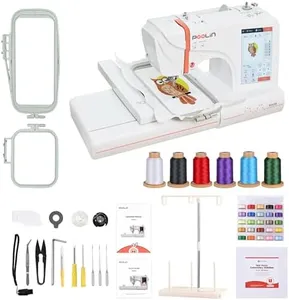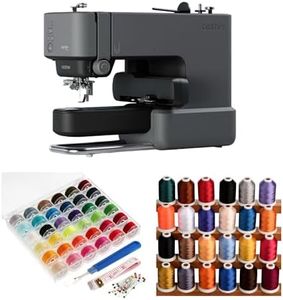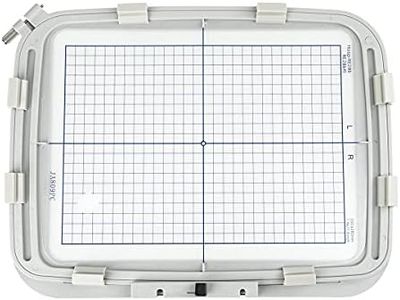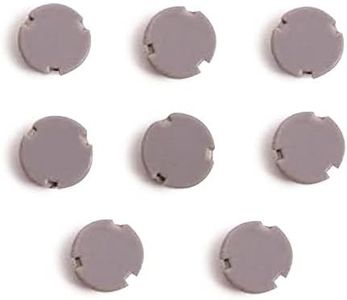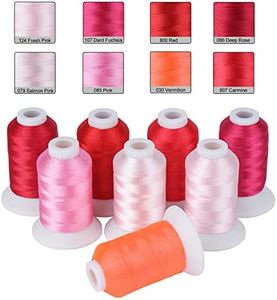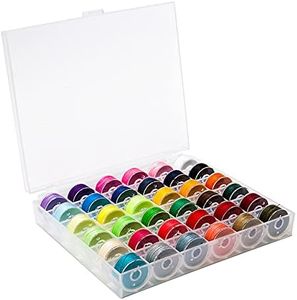We Use CookiesWe use cookies to enhance the security, performance,
functionality and for analytical and promotional activities. By continuing to browse this site you
are agreeing to our privacy policy
9 Best Embroidery Machines
From leading brands and best sellers available on the web.Buying Guide for the Best Embroidery Machines
Choosing the right embroidery machine is important to make sure it matches your projects, skill level, and future plans. Take time to think about what you want to create: small hobby pieces, detailed commercial designs, or personalized gifts. Look for a machine that fits your workspace and feels intuitive to operate. Understanding the main features will help you find a model that keeps you inspired and productive, whether you’re a beginner or advancing your skills.Hoop SizeThe hoop size refers to the maximum area that the embroidery machine can stitch in one go. A larger hoop allows you to tackle bigger designs without needing to re-hoop the fabric, which keeps alignment precise and saves time. Sizes usually range from about 4x4 inches for small projects, up to larger sizes like 6x10 inches or more for bigger, intricate pieces. If you mostly want to make small patches or monograms, a small or medium hoop is fine. If you see yourself making large decorative panels, tablecloths, or quilting projects, consider a machine with a bigger hoop size.
Number of Built-in DesignsThis refers to the number of embroidery patterns already programmed into the machine. More built-in designs mean more creative options right out of the box, which is handy for beginners who may not want to design their own patterns yet. Machines can have just a handful of designs or hundreds. If you prefer simplicity or have very specific tastes, a lower number is sufficient, especially if the machine allows you to import custom designs. If you want a wide variety and immediate inspiration, a machine with lots of built-in options may suit you better.
Connectivity OptionsConnectivity options determine how you load new embroidery patterns onto your machine. Some machines only work with built-in designs, while others offer USB ports, SD card slots, or even Wi-Fi connectivity to let you transfer designs from your computer or download them directly. If you expect to buy or create custom patterns, or want to use designs from the internet, make sure the machine accepts new designs through USB or wireless connections. For those who are happy with built-in designs or don’t wish to fuss with tech, simpler connectivity is sufficient.
Number of NeedlesEmbroidery machines may come with a single needle or multiple needles. A single-needle machine works like a regular sewing machine, changing color threads as needed, making it simple and good for home users. Multi-needle machines hold many colors at once, making them faster and more suitable for frequent, intricate, or commercial use, since you don’t have to change threads as often. If you plan on doing multi-colored projects often or want faster production, a multi-needle machine might be best. For beginners or basic projects, a single-needle is usually enough.
Ease of Use and Display ScreenThe display screen is where you choose designs, edit patterns, and operate the machine. Some machines use simple LCD screens with basic controls, while advanced models offer large color touchscreens that make editing and navigation very easy. Touchscreen displays are helpful for resizing designs and previewing work, which can make the process smoother for beginners. If you are comfortable using tech and want more control, a bigger, interactive screen is great. For those who prefer straightforward operation, a basic screen with simple buttons is sufficient.
Embroidery SpeedThis is usually measured in stitches per minute and affects how quickly you can finish a project. Higher speeds are useful for those wanting to do big or frequent pieces, or for small business purposes. Lower speeds give you more control—great for learning or detailed work. Decide how much speed matters to you based on how often you embroider and the complexity of your designs. For occasional or hobby use, standard speeds are fine, while high speeds are best for those with bigger ambitions.

